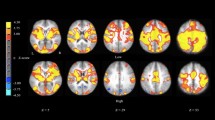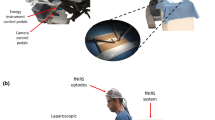Abstract
Background
The goal of this study was to compare the brain activation patterns of experienced and novice individuals when performing the Fundamentals of Laparoscopic Surgery (FLS) suture with intracorporeal knot tying task, which requires bimanual motor control.
Methods
Twelve experienced and fourteen novice participants completed this cross-sectional observational study. Participants performed three repetitions of the FLS suture with intracorporeal knot tying task in a standard box trainer. Functional near infrared spectroscopy (fNIRS) data was recorded using an optode montage that covered the prefrontal and sensorimotor brain areas throughout the task. Data processing was conducted using the HOMER3 and AtlasViewer toolboxes to determine the oxy-hemoglobin (HbO) and deoxyhemoglobin (HbR) concentrations. The hemodynamic response function based on HbO changes during the task relative to the resting state was averaged for each repetition and by participant. Group-level differences were evaluated using a general linear model of the HbO changes with significance set at p < 0.05.
Results
The average performance score for the experienced group was significantly higher than the novice group (p < 0.01). There were significant cortical activations (p < 0.05) in the prefrontal and sensorimotor areas for the experienced and novice groups. Areas of statistically significant differences in activation included the right dorsolateral prefrontal cortex (PFC), the right precentral gyrus, and the right postcentral gyrus.
Conclusions
Portable neuroimaging allowed for the differentiation of brain regions activated by experienced and novice participants for a complex surgical motor task. This information can be used to support the objective evaluation of expertise during surgical skills training and assessment.
Graphical abstract




Similar content being viewed by others
References
Ritter EM, Scott DJ (2007) Design of a proficiency-based skills training curriculum for the fundamentals of laparoscopic surgery. Surg Innov 14:107–112
Fraser S, Klassen D, Feldman L, Ghitulescu G, Stanbridge D, Fried G (2003) Evaluating laparoscopic skills. Surg Endosc 17:964
Modi HN, Singh H, Yang G-Z, Darzi A, Leff DR (2017) A decade of imaging surgeons’ brain function (part I): terminology, techniques, and clinical translation. Surgery 162:1121–1130
Ohuchida K, Kenmotsu H, Yamamoto A, Sawada K, Hayami T, Morooka K, Takasugi S, Konishi K, Ieiri S, Tanoue K (2009) The frontal cortex is activated during learning of endoscopic procedures. Surg Endosc 23:2296–2301
Leff DR, Orihuela-Espina F, Elwell CE, Athanasiou T, Delpy DT, Darzi AW, Yang G-Z (2011) Assessment of the cerebral cortex during motor task behaviours in adults: a systematic review of functional near infrared spectroscopy (fNIRS) studies. Neuroimage 54:2922–2936
Andreu-Perez J, Leff DR, Shetty K, Darzi A, Yang G-Z (2016) Disparity in frontal lobe connectivity on a complex bimanual motor task aids in classification of operator skill level. Brain Connect 6:375–388
Leff DR, Elwell CE, Orihuela-Espina F, Atallah L, Delpy DT, Darzi AW, Yang GZ (2008) Changes in prefrontal cortical behaviour depend upon familiarity on a bimanual co-ordination task: an fNIRS study. Neuroimage 39:805–813
Leff DR, Orihuela-Espina F, Atallah L, Darzi A, Yang G-Z (2007) Functional near infrared spectroscopy in novice and expert surgeons—a manifold embedding approach. In: Nicholas Ayache, Sébastien Ourselin, Anthony Maeder (eds) Medical image computing and computer-assisted intervention. Springer, Berlin, pp 270–277. https://doi.org/10.1007/978-3-540-75759-7_33
Leff DR, Leong JJ, Aggarwal R, Yang G-Z, Darzi A (2008) Could variations in technical skills acquisition in surgery be explained by differences in cortical plasticity? Ann Surg 247:540–543
Nemani A, Yücel MA, Kruger U, Gee DW, Cooper C, Schwaitzberg SD, De S, Intes X (2018) Assessing bimanual motor skills with optical neuroimaging. Sci Adv. https://doi.org/10.1126/sciadv.aat3807
Shetty K, Leff DR, Orihuela-Espina F, Yang G-Z, Darzi A (2016) Persistent prefrontal engagement despite improvements in laparoscopic technical skill. JAMA Surg 151:682–684
Hannah TC, Turner D, Kellner R, Bederson J, Putrino D, Kellner CP (2022) Neuromonitoring correlates of expertise level in surgical performers: a systematic review. Front Hum Neurosci. https://doi.org/10.3389/fnhum.2022.705238
Cope M, Delpy DT (1988) System for long-term measurement of cerebral blood and tissue oxygenation on newborn infants by near infra-red transillumination. Med Biol Eng Compu 26:289–294
Delpy DT, Cope M, van der Zee P, Arridge S, Wray S, Wyatt J (1988) Estimation of optical pathlength through tissue from direct time of flight measurement. Phys Med Biol 33:1433
Boas DA, Dale AM, Franceschini MA (2004) Diffuse optical imaging of brain activation: approaches to optimizing image sensitivity, resolution, and accuracy. Neuroimage 23:S275–S288
Jahani S, Setarehdan SK, Boas DA, Yücel MA (2018) Motion artifact detection and correction in functional near-infrared spectroscopy: a new hybrid method based on spline interpolation method and Savitzky-Golay filtering. Neurophotonics 5:015003
Aasted CM, Yücel MA, Cooper RJ, Dubb J, Tsuzuki D, Becerra L, Petkov MP, Borsook D, Dan I, Boas DA (2015) Anatomical guidance for functional near-infrared spectroscopy: atlasviewer tutorial. Neurophotonics 2:020801
Rosser JC, Rosser LE, Savalgi RS (1997) Skill acquisition and assessment for laparoscopic surgery. Arch Surg 132:200–204
Korndorffer JR Jr, Dunne JB, Sierra R, Stefanidis D, Touchard CL, Scott DJ (2005) Simulator training for laparoscopic suturing using performance goals translates to the operating room. J Am Coll Surg 201:23–29
Fried GM, Feldman LS, Vassiliou MC, Fraser SA, Stanbridge D, Ghitulescu G, Andrew CG (2004) Proving the value of simulation in laparoscopic surgery. Ann Surg 240:518
Modi HN, Singh H, Yang G-Z, Darzi A, Leff DR (2017) A decade of imaging surgeons’ brain function (Part II): a systematic review of applications for technical and nontechnical skills assessment. Surgery 162:1130–1139
Singh-Curry V, Husain M (2009) The functional role of the inferior parietal lobe in the dorsal and ventral stream dichotomy. Neuropsychologia 47:1434–1448
Ietswaart M, Carey DP, Della Sala S, Dijkhuizen RS (2001) Memory-driven movements in limb apraxia: is there evidence for impaired communication between the dorsal and the ventral streams? Neuropsychologia 39:950–961
Howard MA, Volkov I, Mirsky R, Garell P, Noh M, Granner M, Damasio H, Steinschneider M, Reale R, Hind J (2000) Auditory cortex on the human posterior superior temporal gyrus. J Comp Neurol 416:79–92
Duann J-R, Ide JS, Luo X, C-sR Li (2009) Functional connectivity delineates distinct roles of the inferior frontal cortex and presupplementary motor area in stop signal inhibition. J Neurosci 29:10171–10179
Karim HT, Huppert TJ, Erickson KI, Wollam ME, Sparto PJ, Sejdić E, VanSwearingen JM (2017) Motor sequence learning-induced neural efficiency in functional brain connectivity. Behav Brain Res 319:87–95
Khoe HC, Low JW, Wijerathne S, Ann LS, Salgaonkar H, Lomanto D, Choi J, Baek J, Tam WW, Pei H (2020) Use of prefrontal cortex activity as a measure of learning curve in surgical novices: results of a single blind randomised controlled trial. Surg Endosc 34:5604–5615
Crewther BT, Shetty K, Jarchi D, Selvadurai S, Cook CJ, Leff DR, Darzi A, Yang G-Z (2016) Skill acquisition and stress adaptations following laparoscopic surgery training and detraining in novice surgeons. Surg Endosc 30:2961–2968
Kamat A, Makled B, Norfleet J, Schwaitzberg SD, Intes X, De S, Dutta A (2022) Directed information flow during laparoscopic surgical skill acquisition dissociated skill level and medical simulation technology. NPJ Sci Learn 7:1–13
Schreppel T, Egetemeir J, Schecklmann M, Plichta MM, Pauli P, Ellgring H, Fallgatter AJ, Herrmann MJ (2008) Activation of the prefrontal cortex in working memory and interference resolution processes assessed with near-infrared spectroscopy. Neuropsychobiology 57:188–193
Funding
The authors gratefully acknowledge the support of this work through the Medical Technology Enterprise Consortium (MTEC) award #W81XWH2090019 (2020-628).
Author information
Authors and Affiliations
Corresponding author
Ethics declarations
Disclosure
Dr. Cavuoto has no relevant conflicts related to this manuscript and reports having received a research grant from Intuitive Surgical. Pushpinder Walia and Drs. Fu, Intes, De, Schwaitzberg, and Dutta have no conflicts of interest or financial ties related to this manuscript to disclose.
Additional information
Publisher's Note
Springer Nature remains neutral with regard to jurisdictional claims in published maps and institutional affiliations.
Rights and permissions
Springer Nature or its licensor (e.g. a society or other partner) holds exclusive rights to this article under a publishing agreement with the author(s) or other rightsholder(s); author self-archiving of the accepted manuscript version of this article is solely governed by the terms of such publishing agreement and applicable law.
About this article
Cite this article
Walia, P., Fu, Y., Schwaitzberg, S.D. et al. Portable neuroimaging differentiates novices from those with experience for the Fundamentals of Laparoscopic Surgery (FLS) suturing with intracorporeal knot tying task. Surg Endosc 37, 5576–5582 (2023). https://doi.org/10.1007/s00464-022-09727-4
Received:
Accepted:
Published:
Issue Date:
DOI: https://doi.org/10.1007/s00464-022-09727-4




